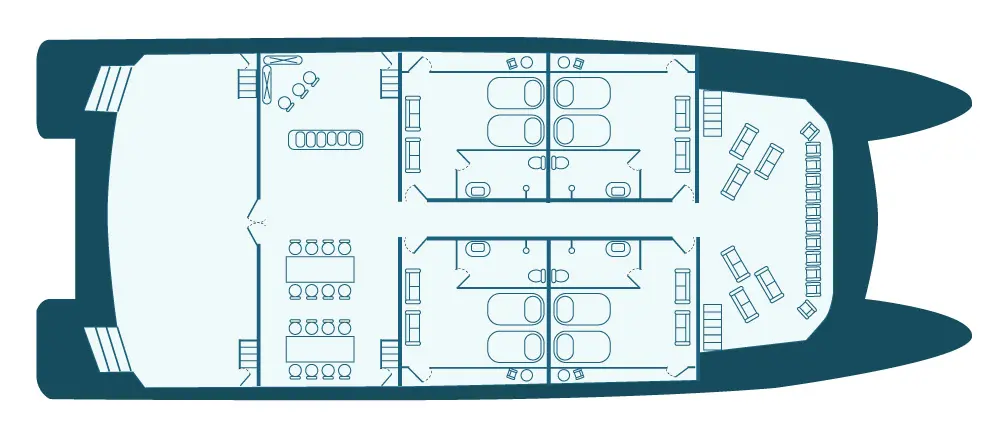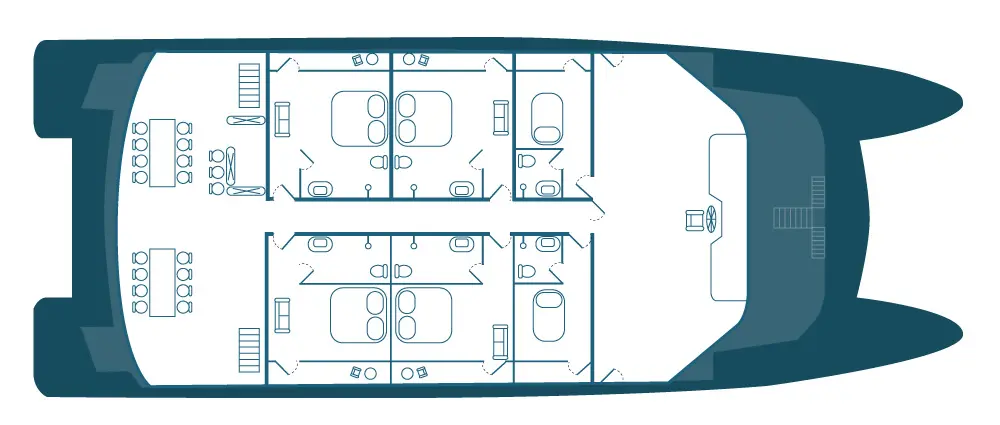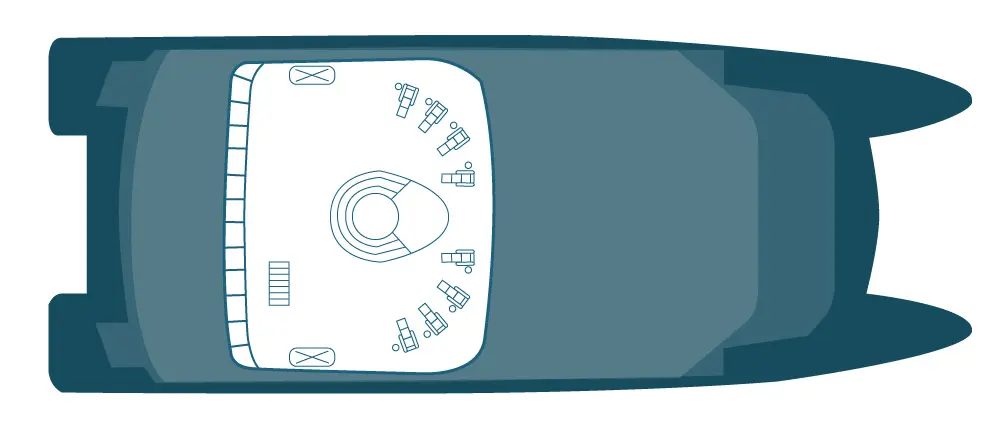Ocean Spray Luxury Catamaran
Capacity
16 guests
Speed
15 knots
Type
Luxury Catamaran
Length
42 m
Ocean Spray
The M/C Ocean Spray has a sleek, fully redesigned interior, and is one of the best options for enjoying the Galapagos Islands in style.
The 16-passenger Ocean Spray was conceived for comfort and stability, offering plenty of space per guest onboard with high-end facilities and amenities.
It has a bright, welcoming briefing area for enriching lectures and talks given by dedicated, top-ranked Naturalist Guides.
The Ocean Spray by Golden Galapagos offers sweeping ocean views from all suites, which are convertible (a king-size bed vs. two twin-size beds) and have luxurious private balconies where our guests can unwind and enjoy the islands while navigating. All of our staterooms feature premium biodegradable amenities, deluxe bed linens, and natural lighting.
Breakfast, lunch and dinner is served al-fresco in the upper deck lounge or in the indoor dining room.
At the top of the catamaran, guests can enjoy the sky deck, which has a whirlpool and comfortable lounge chairs. It is also ideal for spotting wildlife from aboard the vessel.
The passenger briefing lounge and social areas of the Ocean Spray are very spacious, and there is also a library available for reading about both the Galapagos and Ecuador in general. All excursions are guided by top-ranked naturalist guides, offering unique moments with the endemic Galapagos wildlife while out on excursions.
Each guided excursion features walks, kayaking, snorkeling, paddle boarding, Zodiac rides, wildlife observation, and many more surprises.
Included
- Accommodations
- All meals
- Soft drinks
- Island sightseeing
- Naturalist guides and lecture services in English/Spanish only
- Wet suit rental, snorkeling gear
- Taxes and transfers in the islands
Excluded
- Air transportation to / from Galápagos and airport taxes (subject to change without previous notice).
- Galápagos National Park entrance fee (US$ 100 subject to change without previous notice).
- INGALA migration Control Card (US $ 20 subject to change without previous notice).
- Alcoholic beverages, gratuities, gifts and additional items.
Starting
$0.00
/ person
Book This Tour
Itineraries
– Day 1:
AM: Flight to Galapagos
Upon arrival at San Cristobal airport, visitors must go through an inspection in order to verify that no foreign plants or animals are being introduced to the islands. An entrance fee of $100 (unless it has been prepaid) must be paid to the Galapagos National Park in order to conserve the islands. A representative of our M/Y Galápagos Se Star Journey, will meet you right outside an, help collect your luggage, and escort your bus ride to the harbor.
PM: Puerto Chino and Breeding Center
In the afternoon, you will visit Puerto Chino. It is rife with huge cactus over the trail like trees. Once you get on the beach, you will enjoy its surroundings with it wildlife. Sea lions share the beach with people so its common see the puppies playing and swimming. Enjoy the deep blue waters with the waves and tide, occasionally there is wildlife to see, especially tortoises. After, you will visit the Breeding Center Jacinto Gordillo, also known as the “Galapaguera” is a good place to observe Galapagos tortoises in its natural habitat. San Cristobal island has endemic species such as: the Mockingbird Nesomimus melanotis, lava lizard (Microlophus bivittatus), Chatham Leaf-toed Gecko (Phyllodactylus leei) and the tortoises. All of these species can be observed in this place, the beach is really big and it works as a nesting zone for marine tortoises.
– Day 2:
AM: Suarez Point
This area is great for spotting blue-footed boobies, albatrosses and Nazca boobies. A beautiful site on the oceanfront, the large waved albatrosses use the cli as a launching pad. The famous attraction is the magni cent blowhole, spurting water high into the air at least from 50 to 75 meters high. This site presents wonderful photograph opportunities.
PM: Gardner Bay
Located on the north-eastern coast of Hood, Gardner Bay o ers an excellent beach to relax, swim and even kayak, plus the opportunity to observe sea lions (Zalophus wollebaki),. Here we can also observe sharks in the crystal clear ocean waters. At this place one can see three species of Darwin nches: A subspecies of the large-billed cactus nch (Geospiza fuliginosa), which is similar to the large-billed terrestrial nch; The small-beaked ground nch (Geospiza fuliginosa and the singing nch (Certhidea Olivacea) which is another endemic subspecies. Both resident and migratory birds are observed. It is worth to notice that this zone is really important for marine tortoises nesting, specially the (Chelonia mydas).
– Day 3:
AM: Punta Cormorant, Floreana Island
This site o ers probably the best Flamingo lagoon in the Galapagos; it is also one of the largest in the islands. It’s situated between two tu lava cones that give the area a special atmosphere. There are various species of shorebirds to observe besides amingos; the most frequent are common stilts, white-checked pintail ducks and other migratory birds. It is very interesting to see the two distinct beaches: “The Green Beach” (due to its high percentage of olivine crystals in the sand) and the “Flour Sand Beach” which is made up of coral.
PM: Post o ce bay & Baroness Lookout, Floreana
Historically, this site is the location of a wooden barrel that was placed in the 18th century by the crew of a whaling ship. It has been used since this time by marines and tourists as a post o ce. The idea is to carry letters or postcards to their destination by hand. Apart from being the Post O ce Barrel, this site was the landing area for some of the rst colonists. We will continue to the north of the island and will ascend to an elevated slope to enjoy a beautiful vista at the Baroness Lookout. It is said that Baroness Eloisa von Wagner loved this place and spent several hours watching the horizon. Within walking distance (30 m) the ruins of what is known as her House can be seen. From this lookout, the landscape covers the coastline from the Enderby islet to Post O ce Bay, as well as Cerro Pajas, the pool of amingos and wide forest of Palo Santo.
– Day 4:
AM: Santa Fe
Located on the southeastern part of the Galapagos, this island was formed from an uplift, this is why it is mostly at. There are some theories which assure this could be the oldest island in the Archipelago. Santa Fe is the home of a number of endemic species like the Galapagos Hawk, Galapagos snake, Galapagos mockingbird, rice rats and one of the two species of land Iguanas on the islands. After disembarkation in the beautiful and clear waters, you will be in contact with one of the many sea lion colonies. Along the trail, many salt bushes can be seen as well giant as Pickly pear cactus. Gigantism is a characteristic of oceanic islands. There are great possibilities of snorkeling with playful sea lions and tropical fish.
PM: South Plazas
Plazas is located at the east of Santa Cruz Island, and forms part of two islands known as Islas Plazas. Despite its small size, some of the most interesting and outstanding species of the Galapagos are found here. The Plazas land iguanas are smaller than its relatives found at other islands. Throughout the island we may see several hybrid iguanas, a result of crossing a male marine iguana and a female land iguana, they are unique, recognizable at rst glance by their black/gray color, with a land iguana’s crest, but face and tail of the marine iguana. The big population of iguanas is given due to the presence of tunas, their favorite food, which encourages reproduction and adaptation. Swallow Tailed Gulls nesting in the rugged cli s are seen along with other seabids such as: Audubon shearwaters, red-billed tropicbirds, frigate birds and brown pelicans.
– Day 5:
AM: North Seymour Island
Seymour is an uplifted (as opposed to volcanic) island and so is generally at and strewn with boulders. There are good nesting sites here for a large population of magni cent frigate birds. Blue-footed boobies perform their courtship dance in the more open areas and swallow-tailed gulls perch on the cli edges. Despite the tremendous surf that can pound the outer shore, sea lions haul out onto the beach and can be found bodysur ng. Watch your step, as the boobies don’t worry much about where they nest, and you might just step on one. The trees are dotted with male frigate birds trying to attract the attention of the ladies by in ating their bright red skin aps. They sometimes y in the air to call more attention to themselves. There’s a circular path that takes you through the island to a beautiful, rocky shore where the waves crash a silvery-blue. This truly is one of the most varied and interesting experience you will live through.
PM: Bachas Beach, Santa Cruz Island
These two small beaches are found to the West of Turtle Cove. Their sand is made of decomposed coral, which makes it white and soft, making it a favorite nesting site for sea turtles. Behind one of the beaches there is a small brackish water lagoon, where it is occasionally possible to observe amingos and other coastal birds, such as black-necked stilts and whimbrels. The other beach is longer, but it has two old barges that were abandoned during the Second World War, when the USA used Baltra Island as a strategically point to protect the Panama Channel.
– Day 6:
AM: Mosquera Islet
Mosquera Islet is located between Baltra and North Seymour. This is a small islet formed by a geological uplift, with a reef of rocks and coral and a great white sand beach, where lie a big population of sea lions. You can also observe several species of shorebirds. This site o ers great snorkeling and swimming. Along the rocks are commonly running Red Lava crabs or Sally light-foot crabs. Then transfer to Baltra Airport for ight back home
– Day 1:
AM: Flight to Galapagos
Upon arrival at Baltra Airport, visitors must go through an inspection in order to verify that no foreign plants or animals are being introduced to the islands. An entrance fee of $100 (unless it has been prepaid) must be paid to the Galapagos National Park in order to conserve the islands. A representative of our M/Y Galápagos Se Star Journey, will meet you right outside an, help collect your luggage, and escort your bus ride to Puerto Ayora Village.
PM: Dragon hill, Santa Cruz Island
The visitor site at Dragon Hill has been opened for visits since 1993. This site is located in northwestern Santa Cruz Island and consists of a trail that leads to a hyper-saline lagoon behind the beach, frequented by amingos, pintail ducks and other species of birds. This site has been re populated with land iguanas from Seymour, Isabela and Santa Cruz islands. There is a short walk to the Hill, which o ers a beautiful view of the bay.
– Day 2:
AM: Black Turtle Cove
This little cove is located at the northern side of Santa Cruz island, this is a red mangrove lagoon very calm and quiet which made an ideal place as nursery for many sharks and rays. Its crystal waters permits to observe large groups of white-tip reef, black tipped reef and hammerheads sharks, schools of golden rays and spotted eagle rays. There are no landing sites so the visit is done by panga or kayak. Sea turtles are frequently seen and sometimes they are seen mating in the mangrove-lined waters. Pelicans and Herons are also seen in this area.
PM: Chinese hat
This is a small islet (1 sq km) located just o the southeastern tip of Santiago Island. It is a recent volcanic cone, shaped like a Chinese hat when seen from north side. On the west lava formations it can be seen , formed under the sea and raised upward, this is why coral heads are found on the lava. This is an excellent visit for interpretation of geological features such as lava tubes and lava ows. The landscape is covered by sea lions colonies, marine iguanas and Galapagos penguins.
– Day 3:
AM: El Barranco
The visitor site of El Barranco is located in the southern part of Darwin Bay from Genovesa Island. The trail is on volcanic rock, consists of 1.5 km and can be done in about 2 hours. The youngest area of the island, from a geological point of view, lies on this area. The cli is located in the south, are composed of very fragile lava. The natural erosion in these lava ows has become the ideal place for nesting Storm Petrels. You can see two species of petrels that nest in cavities and holes in the lava. One of its main predators is the short-eared owl. The red-footed booby nests only in the outer islands of the archipelago, Punta Pitt, Gardner (Floreana), Wolf, Darwin and Genovesa. Also present on this island is the masked booby. During the “panga rides” along the cli s, fur sea lions and several species of seabirds can be seen.
PM: Darwin Bay
This bay has its origin when the crater of this island collapsed below sea level. The wet landing is on a beautiful white coral sandy beach. This is a favorite island for birdwatchers that allow the following species to be seen: red footed-booby, masked boobies, wandering tattlers, lava gulls, whimbrels, yellow-crowned, and black-crowned lava herons, and yellow warblers. Continuing on the trail, visitors climb gradually to the edge of the cli seeing Red-Foots nesting in the Mangrove trees below. Bird watching includes sightings of sharp-beaked nches, large cactus and ground nches, Galapagos doves, and swallow-tailed gulls. Reaching the end of the trail, at the cli ’s edge an incredible view of the island and the many birds living there can be observed.
– Day 4:
AM: Bartolome Island
Bartolome Island is situated across Sullivan Bay. It has an altitude of 114 meters, from where we can observe one of the most beautiful sceneries of the Galapagos Islands such as: Volcanic cones, lunar-like craters, lava elds, and the famous Toba formed pinnacle eroded by the sea. There is very little vegetation on this island. It has two breathtaking beaches where marine turtles exist and at the base of the pinnacle, as well as a very small colony of Galapagos penguins
PM: The Sullivan Bay, Santiago Island
Santiago, also called James, or San Salvador Island, is located in the west central part of the Galapagos archipelago. It is the fourth largest island in the archipelago (following Isabela, Fernandina and Santa Cruz). Along with some of the large western volcanoes of Isabela and Fernandina, Santiago is also volcanically active, with many young ows and cones to be seen, particularly along the south, west, and east coasts. These may even be seen from the summit of Darwin Volcano and from space. A number of historic eruptions have been reported over the last 2 centuries. Santiago actually consists of two coalesced volcanoes: a typical shield volcano on the northwest end and a low, linear ssure volcano on the southeast end.
– Day 5:
AM: Highlands, Santa Cruz Island
The trail to the highlands leaves from Bellavista and passes through the agricultural zone, near the National Park boundary, the Miconia Zone, and then goes to the Fern and Sedge zone. With clear weather (unpredictable) this area a ords beautiful scenes of rolling hills and extinct volcanic cones covered with grass and lush greenery all year round. After the morning excursion you will be taken to the airport for your ight to the mainland. Baltra airport.
Deck Plans
Contact Us:
- Address: Checoslovaquia E9-95 St., Eveliza Plaza building. Quito-Ecuador
- jorge@exclusiveecuador.info
- TOLL FREE USA & CAN 1-866-454-9060
- TELEPHONE UK +44-2033-724723
- TELEPHONE ECUADOR +593-2-333-3718
- MOBILE ECUADOR +593-99-281-3776




